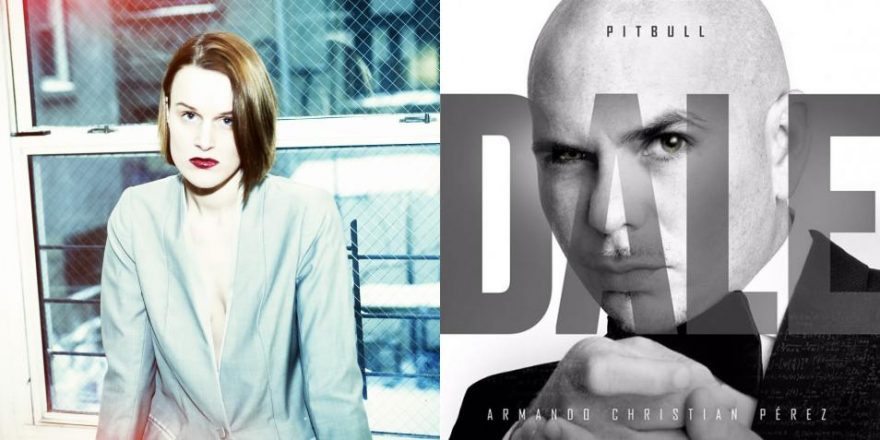Listen: I like techno. I like pop. I even like it when they’re mashed together into TECHNO-POP. (Is Alice Deejay’s “Better Off Alone” the sonic Mona Lisa of our times? Seriously, I am wondering.) What makes a good techno-pop track is a strong emotional epicenter (not necessarily a verbal one)—probably some kind of soul-searching or ecstatic immensity of feeling that would normally be a little too much (see: INOJ’s “Love You Down;” Benny Benassi’s “Satisfaction;” Frankie Knuckles’ “Baby Wants To Ride”). Without some good, old-fashioned lugubrious pop psychosis, techno-pop songs are forgettable and numbing.
This is why, even though I know she’s a gifted songwriter and an immense badass, I always had a hard time with Kesha. Her raucous love letters to having a good time were hard for me to believe in; their migraine-inducing Whac-A-Mole persistence didn’t always feel true to the fun she was singing about. Plus, it’s hard to get a read on her vibe when her voice is shellacked by Autotune. (Autotune is not objectively wrong—it’s just grossly, thoughtlessly overused.). Especially now, it’s bizarre to hear 2012-Ke$ha cheerily exclaim, “Let’s make the most of the night like we’re gonna die young!” in grim-as-hell “no more healthcare and lots of black and brown kids are still getting killed by cops” 2017.
Still, Kesha has long been an extremely prodigious songwriter both for herself and others. She’s always known a million ways to do pop right, so, over the years, I wondered why she stuck with such a limited, tensionless formula. It seemed like the “Ke$ha” brand was built like a Transformer robot gone wrong: a vehicle for both commercial success and a seemingly inescapable prison. The events that unfolded publicly about how her first two albums, 2010’s Animal and 2012’s Warrior, were made speak to some reasons for why that might have been.
In 2014, Kesha publicly named her Kemosabe Records producer, Lukasz Gottwald, aka Dr. Luke, as her rapist and sued him for the infliction of emotional distress, hate crimes, and discrimination, with the goal of being allowed to leave a record contract with Sony that specified she continue to work with him to record her albums. As a result of Dr. Luke’s abuse, Kesha spent six months in rehab for an eating disorder the producer encouraged: “I tried to [starve myself] and almost killed myself in the process,” the singer said. In response, Dr. Luke called her a liar and countersued her for defamation, claiming that she only sued him for professional gain. Even famous and wealthy survivors are punished for speaking up about sexual assault: In 2015, Kesha’s attorney warned the case would spell her career’s end. Most pop stars release new music every few years, but the litigation Kesha was embroiled in meant she had to wait five. Survivors know there are few perks associated with reporting rape or sexual assault, but YouTube commenters still grouse about Kesha “playing the victim” to sell records. This flawed logic is common in our rape culture. It denies the fact that survivors are rarely afforded the security or space to seek healing, let alone justice—and that male entitlement is woven into the fabric of the music industry and can be the determining factor in whether or not music written by women gets made at all. As Grimes commented on Kesha’s case in 2016, “I’ve been in numerous situations where male producers would literally be like, ‘We won’t finish the song unless you come back to my hotel room.’” This is a disease robbing us of our lives, voices, and stories.
Kesha did not win her 2014 case against “Dr. Luke” (quotation marks my own—on top of being an awful human, this dude has such wack style he dubbed himself “Dr. Luke,” as if this weren’t the nomenclatural equivalent of a checkerboard fedora). “Dr. Luke” was deposed as the CEO of Kemosabe Records, the imprint to which he signed Kesha when she was 18, by Sony in April 2017. But his case against her still stands, and Kesha was conteac. Though going to court against your abuser is too expensive and traumatic for most, Kesha went public to save herself and show other survivors they weren’t alone. Public outpouring of support left the singer’s face “swollen in tears.” In a video message to fans, Kesha thanked them for getting her through the darkest time of her life.
This liberated and open—if often pained—perspective is omnipresent on Kesha’s new album, Rainbow. Considering the journey, this album’s existence alone is inspiring. But Rainbow is also musically scaling heights we’ve never heard from Kesha before (she literally hits a Mariah high note on heavy-hitting ballad “Praying”), the first of her albums on which she’s made enough space to command the many sides of her multi-faceted self. Instead of finding Kesha at the end of her career, Rainbow seems to spell excellent new things about the impact and scope of her music now and in the future.
Rainbow is Kesha’s least techno-indebted album to date. The album opens with “Bastards,” three minutes of acoustic guitar and Kesha’s confident insistence that you pay little mind to people who don’t care about you. For an artist hailing from the land of EDM, opening a “rebirth” record with neither is as musically bold as it is wise. The immediate implication is that Kesha can sing and carry a more nuanced song without the assistance of Autotune, so we can hear just how expressive her voice really is. Just as “Bastards” floats away into a melodic, echoing “na na na” chorus, “Let ’Em Talk”springs into power-pop heavy riff action. Hell yeah, Kesha! It is hard for me to not feel proud of her for this well-executed, exuberant track. Her classic “IDGAF” nature is having a renaissance, but she employs it here as a means of self-defense and care. She sounds like a cool older sister dispelling any anxiety you might have about people who talk behind your back. Who cares? People are jealous, the singer says. Don’t worry about it: “Loves and hates, they don’t really know you.” Sound advice from someone who has been both beloved and belittled far and wide and lived to tell the tale.
Kesha’s music and image have long pointed to the singer’s feminism with believable conviction. Part of what made the singer such an easy target for ridicule in the early days of her career was her unwillingness to conform to acceptable, respectable notions of how a woman ought to be. “Tik Tok” was the worldwide best-selling single of 2010, but instead of being lauded for her preternatural pop mastery, “Ke$ha” was characterized as a silly, clownish slut. Still, though it wasn’t en vogue to identify as a capital-F feminist when she debuted with “Tik Tok,” the singer “wanted to talk about men the way men talk about women,” she said. “I’m a young, responsible woman who can work and party as hard as any man. So, if I want to talk about drinking and sex, I’m going to do it.” As Rainbow progresses, “Woman,” Kesha’s playfully astute ode to being in charge of her own life, brings her politics into sharp focus in the present day. Its lyrics are heavy-handed on paper (“I’m a motherfucking woman, all right? I don’t need a man to be holding me too tight”), but her phrasing as she belts this out loud makes it work. The addition of the Dap-Kings’ horns makes the whole thing a very satisfying sort of “Independent Women, Pt. I” for the 2017 set. I love the idea of middle- and high school–age kids singing along to anthemic songs like “Woman” and “Learn To Let Go.”
On Rainbow as a whole, it’s nice to hear the artist’s influences untethered from the intention to carbon-copy them. Thoroughly cohesive, and employing a bevy of producers and songwriters from genres outside previous Kesha releases, Rainbow is both an emotionally and musically daring album. Rainbow’s title track is the only one on the album produced by Ben Folds, but this release has the piano-playing songwriter’s influence all over it. Dramatic, unfurling songs that feel more like mini-plays are Ben Folds’ specialty (as on his tracks “Narcolepsy”, “One Angry Dwarf and 200 Solemn Faces,” and “Fired”), which makes for a nice spiritual guide to the more glam-rock undertones suggested by Rainbow’s cover art, designed by Robert Beatty. Tracks like “Let ‘Em Talk,” “Praying,” “Finding You,” and “Old Flames” showcase Kesha’s uncommonly wide-ranging understanding of various musical styles. It doesn’t feel like awkward dress-up—it feels like Kesha wants us to see all of her other faces, which were previously only hinted at in her songwriting work for others.
“Ke$ha” and “Kesha” meet in the most interesting way on the verses of “Finding You,” where a backwoods, finger-picked guitar riff is set askew by Kesha’s own meandering vocal melody. With different drums, a slide steel guitar or a more twangy chorus, this might’ve been a full-on country-radio crossover. Kesha’s never shied away from being a Nashville girl, and hearing her duet with God herself, Dolly Parton, on Dolly’s own song, “Old Flames Can’t Hold a Candle to You,” is a delight. It’s about nostalgia for lost love, but I like to think it’s a testament to the song’s co-author—Kesha’s mother, Pebe Sebert—and all the women like Parton who may have inspired Kesha’s journey and fortified her strength.
The comic-book imagery on Rainbow is rife with spaceships and boogeymen, appropriately larger-than-life metaphors that may have helped the singer describe the real-life nightmares of surviving sexual assault, fighting back against your abuser and an entire industry complicit in holding women hostage. Kesha waged this battle for an audience of paparazzi flashbulbs and the infinite peanut gallery of gawkers on the internet, probably an intensely lonely feeling. “Spaceship” is about bottomlessly longing for unidentified flying objects, which symbolize a family you’ve never known: “Been living in a lonesome galaxy, but in my dreams I see them come and rescue me.”
“Godzilla,” another song written by Pebe Sebert, is ostensibly about falling in love with an unpopular person. The song rhetorically asks what you get when you date Godzilla: someone who terrorizes the mall and your mom (who calls the cops), but also someone Kesha can manage. “I try to explain he’s mostly tame, so long as there’s pizza and video games.” Maybe I’m stretching it, but I like to think this song might be about learning to live with—and love—monstrous-feeling parts of yourself. It leads me to recall, from the details of the Dr. Luke fallout, how Kesha spent 60 days in rehab for what she called a “relentless” eating disorder. Sounds about right: Eating disorders are gnarly, amorphous beasts which are still misunderstood and scoffed at by those who don’t struggle with them. Wealth, white privilege, and misogyny often make eating disorders seem like an exclusively “rich white-girl problem,” but they wreak hellish, life-threatening havoc on millions of people who are not wealthy, white, or female. Many people are not “cured” of eating disorders, which is perhaps what Kesha meant in describing the unending nature of her struggle. Maybe “Godzilla” makes peace with this hardship, instead of trying to push it away.
It takes time to learn to live with people you don’t like, especially when one of them is yourself. Rainbow’s key strength is its refusal to force its protagonist into a neat and tidy happy (or fun-as-hell) ending. Instead, Kesha’s music has grown out of simply living for the good times and into a passionate choice for living through even the pain, demons, and struggles that are far from over. She’s not simply the party girl we once knew, she is a human being reminding us that sometimes, shit sucks. Instead, having a good time in spite of, and maybe because of, darkness lends a gravity and passion to Kesha’s voice that makes the party that much more fun.







